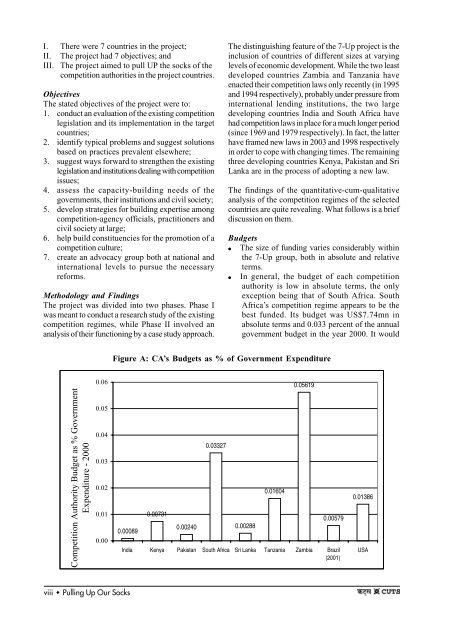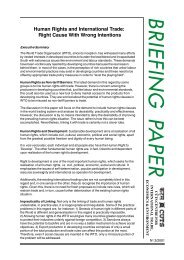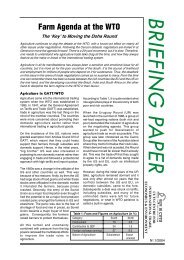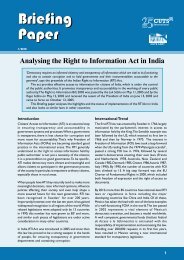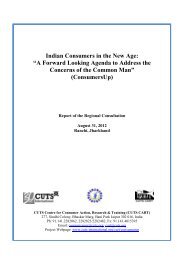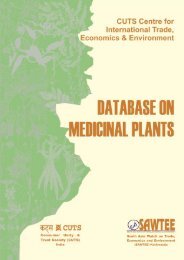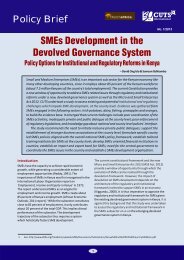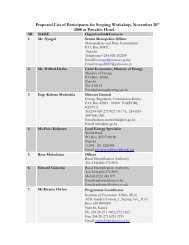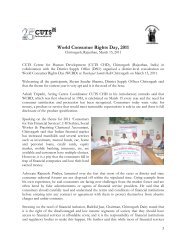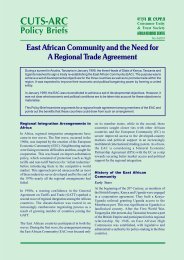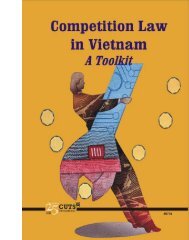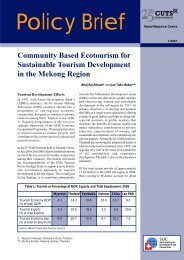Final Report - World Trade Organization
Final Report - World Trade Organization
Final Report - World Trade Organization
You also want an ePaper? Increase the reach of your titles
YUMPU automatically turns print PDFs into web optimized ePapers that Google loves.
I. There were 7 countries in the project;<br />
II. The project had 7 objectives; and<br />
III. The project aimed to pull UP the socks of the<br />
competition authorities in the project countries.<br />
Objectives<br />
The stated objectives of the project were to:<br />
1. conduct an evaluation of the existing competition<br />
legislation and its implementation in the target<br />
countries;<br />
2. identify typical problems and suggest solutions<br />
based on practices prevalent elsewhere;<br />
3. suggest ways forward to strengthen the existing<br />
legislation and institutions dealing with competition<br />
issues;<br />
4. assess the capacity-building needs of the<br />
governments, their institutions and civil society;<br />
5. develop strategies for building expertise among<br />
competition-agency officials, practitioners and<br />
civil society at large;<br />
6. help build constituencies for the promotion of a<br />
competition culture;<br />
7. create an advocacy group both at national and<br />
international levels to pursue the necessary<br />
reforms.<br />
Methodology and Findings<br />
The project was divided into two phases. Phase I<br />
was meant to conduct a research study of the existing<br />
competition regimes, while Phase II involved an<br />
analysis of their functioning by a case study approach.<br />
The distinguishing feature of the 7-Up project is the<br />
inclusion of countries of different sizes at varying<br />
levels of economic development. While the two least<br />
developed countries Zambia and Tanzania have<br />
enacted their competition laws only recently (in 1995<br />
and 1994 respectively), probably under pressure from<br />
international lending institutions, the two large<br />
developing countries India and South Africa have<br />
had competition laws in place for a much longer period<br />
(since 1969 and 1979 respectively). In fact, the latter<br />
have framed new laws in 2003 and 1998 respectively<br />
in order to cope with changing times. The remaining<br />
three developing countries Kenya, Pakistan and Sri<br />
Lanka are in the process of adopting a new law.<br />
The findings of the quantitative-cum-qualitative<br />
analysis of the competition regimes of the selected<br />
countries are quite revealing. What follows is a brief<br />
discussion on them.<br />
Budgets<br />
l The size of funding varies considerably within<br />
the 7-Up group, both in absolute and relative<br />
terms.<br />
l In general, the budget of each competition<br />
authority is low in absolute terms, the only<br />
exception being that of South Africa. South<br />
Africa’s competition regime appears to be the<br />
best funded. Its budget was US$7.74mn in<br />
absolute terms and 0.033 percent of the annual<br />
government budget in the year 2000. It would<br />
Figure A: CA’s Budgets as % of Government Expenditure<br />
0.06<br />
0.05619<br />
Competition Authority Budget as % Government<br />
Expenditure - 2000<br />
0.05<br />
0.04<br />
0.03<br />
0.02<br />
0.01<br />
0.00<br />
0.00089<br />
0.00731<br />
0.00240<br />
0.03327<br />
0.00288<br />
0.01604<br />
0.00579<br />
India Kenya Pakistan South Africa Sri Lanka Tanzania Zambia Brazil<br />
(2001)<br />
0.01386<br />
USA<br />
viii w Pulling Up Our Socks


